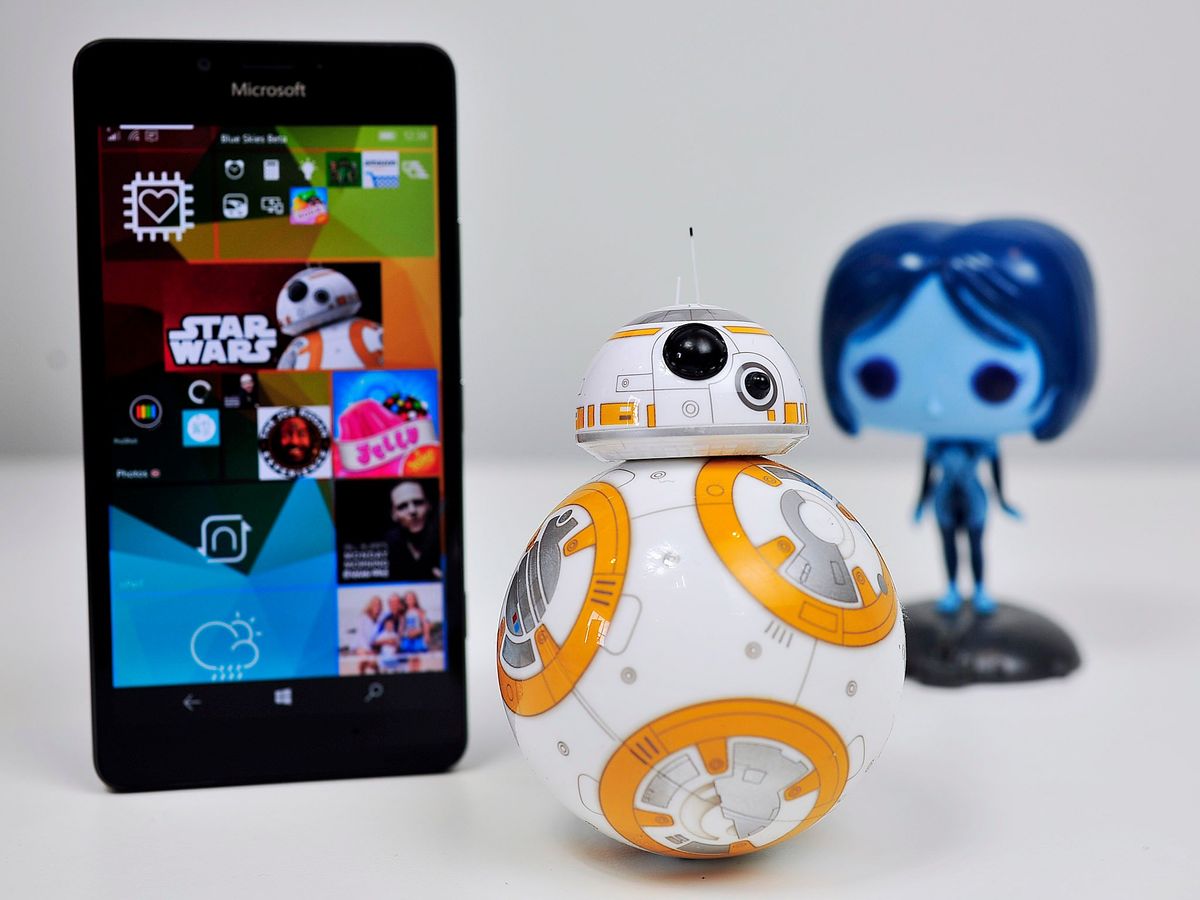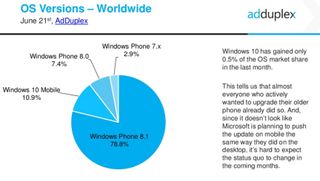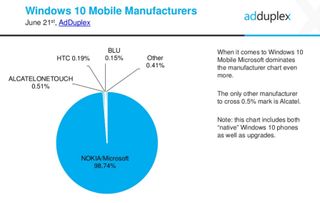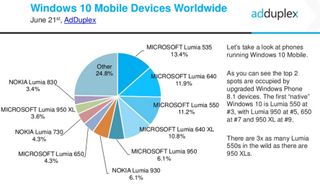Windows 10 Mobile stalls at 11 percent of entire Windows phone market

The latest numbers for AdDuplex reveal that the Windows 10 Mobile share of the whole Windows phone market is holding steady at 11 percent for the month of June.
Windows 10 Mobile commands 10.9 percent, which is only a 0.5% increase over last month. The Windows Phone 8.1 OS meanwhile dominates with 78.8 percent. Windows Phone 8.0 (7.4%) and Windows Phone 7.x (2.9%) come in at a distant third and fourth respectively.

It is apparent that all of those who were offered the ability to upgrade to Windows 10 Mobile already did. Although we are expecting the Lumia Icon and a few others to join the fold their impact to these overall stats will likely be minimal.
Last month's numbers showed that 75 percent of Windows 10 Mobile devices were upgrades and not new purchases.
Microsoft is not nearly as aggressive in pushing Windows 10 updates for Mobile as they were for PC partially due to more limited capability and excluding the low-end market by not offering the upgrade to phones with 512MB of RAM. It looks like Microsoft will have to rely on new device purchases if they want Windows 10 Mobile to grow. Additionally, users need to download a separate Upgrade Advisor app to get Windows 10 Mobile, as it is not a standard phone update. Windows 10 Mobile is much more an opt-in upgrade and the bar to discover that your phone is even eligible is higher than usual.
Most recent estimates put all Windows Phones at 1 to 3 percent of the entire smartphone market when compared to iOS and Android. If only 11% of that 1-3% is Windows 10 Mobile that is indeed a very small active install base.
Windows 10 Mobile by phone model
While more OEMs are releasing Windows 10 Mobile devices, it is more of a slow trickle than a tsunami. The AdDuplex numbers also demonstrate that nearly 99 percent (98.74) of all Windows 10 Mobile devices out there (native and upgrades) are Microsoft. Alcatel OneTouch is a distant second with just 0.51 percent, and HTC and BLU are not too far behind.
Get the Windows Central Newsletter
All the latest news, reviews, and guides for Windows and Xbox diehards.

Ironically, this is the opposite effect of what Microsoft wants, which is for their OEM partners to step up and take over low and mid-range Windows phones. So far, that has not happened at all.
Breaking those numbers down even further by phone model and we can see the Lumia 535 is the top Windows 10 Mobile device (13.4%). The Lumia 640 (11.9%) and Lumia 550 (11.2%) coming up for the second and third spots.
The more expensive Lumia 950 is in the fifth spot with 6.1 percent of the Windows 10 Mobile space. Likewise, the Lumia 650 is number seven (4.3%), and surprisingly the Lumia 950 XL is way back in ninth place with just 3.6 percent.
Clearly, the Lumia 950 is outselling the Lumia 950 XL by a lot. AdDuplex points out that there are three times as many Lumia 550s in the wild as there are Lumia 950 XLs, which is fascinating.

Microsoft still has a lot of work in Mobile before they can even begin to turn it around. While the OS is steadily improving and will be part of the Windows 10 Anniversary Update, it will take a lot of effort and compelling hardware before users start buying devices again.
In the next few months, we should see if HP has any success with the highly-anticipated HP Elite x3 "super phone."
About AdDuplex
The numbers from AdDuplex are collected through their in-app advertising that is prevalent in over 5,000 apps in the Windows Store. That data serve as an important metric within the Windows Phone ecosystem. The full AdDuplex report for June will be posted on their blog at https://blog.adduplex.com/ on Friday (June 24).

Daniel Rubino is the Editor-in-chief of Windows Central. He is also the head reviewer, podcast co-host, and analyst. He has been covering Microsoft since 2007 when this site was called WMExperts (and later Windows Phone Central). His interests include Windows, laptops, next-gen computing, and wearable tech. He has reviewed laptops for over 10 years and is particularly fond of 2-in-1 convertibles, Arm64 processors, new form factors, and thin-and-light PCs. Before all this tech stuff, he worked on a Ph.D. in linguistics, performed polysomnographs in NYC, and was a motion-picture operator for 17 years.